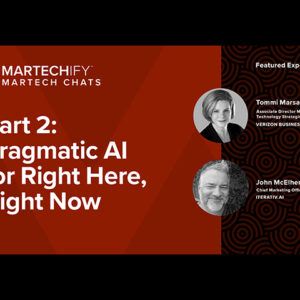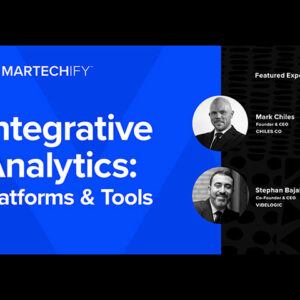Unlock the Power of AI in ABM
- Lorena Harris, Senior ABM Strategist, Ascend Marketing
- Account Based Marketing (ABM), AI and Automation, Managing Org Transformation, Multi-Channel Journeys, Sales and Marketing Orchestration
Is ABM the same as Demand Gen?
ABM is a form of demand generation, but the terms are not synonymous, because demand (or lead) generation generally focuses on target individuals. And of course, account-based marketing is about whole accounts. Just like we as marketers try to guide individuals on a customer journey, we also want to take accounts on a buying journey. And buying committees can have multiple members that need to be nurtured concurrently.
Large enterprises typically have a target who is considered to be the “champion,” the person leading the charge to procure a set of services or software. But we might also need to target the person who controls the budget, plus lots of different influencers and ratifiers: technology, security, legal and, of course, procurement. And sometimes users are involved to test product performance. All these people are part of the buying group/committee for a large-ticket item, and each needs targeted pieces of information in the right format at the right time. Most companies are not skilled at this core aspect of ABM.
The big difference between demand generation and account-based marketing is that, rather than focusing on one buyer, you’re trying to bring a scattered team of people through a journey. And you’re trying to design that journey so that relevant information goes to the right person at the right time in a way that helps the whole group move forward. It’s not as easy as it sounds, but it can be rewarding.
Real-world example: A few years ago, I was helping Mouser, which is like Amazon for electronic components. I’d never thought of it, but everything built by engineers must start from parts–and Mouser warehouses and ships them all. The marketing team at Mouser was targeting engineers because they are the people who need parts to build things.
After an ABM workshop that included sales, the marketing team learned that procurement officers are often making the buying decisions. They might get requests from engineers, but if they don’t know of Mouser and don’t have a contract in place, it just isn’t going to happen. So marketing started a procurement awareness campaign and worked with their legal group to streamline onboarding. Contractual business spiked.
Lesson learned: Expand your thinking beyond traditional targets.
Can you buy ABM?
Purchasing a SaaS platform is not a prerequisite for ABM. Yes, there are full-functionality brands you’ve heard of, like Demandbase and 6sense, and there are a gazillion niche offerings in the ABM realm. But no matter what’s in your toolkit, you still need a plan and people to execute it.
I often encounter companies who are doing elaborate due diligence to acquire ABMtech, thinking it will quickly triple business. But the tool is only as good as the carpenter. Many teams only use a fraction of their stack functionality. And many companies have acquired so many partially connected platforms that productivity decreases as workers try to bridge the gaps with manual processes. AI promises to be a big help in these cases.
While executives are willing to fund extensive martech stacks, they often fail to fund headcount. They decide to pilot their new ABM software “on the side,” giving the stretch assignment to a promising director with a few green reports. Then they underfund and neglect it all. Sales and marketing continue to work in silos and, before long, that director departs and the whole thing fizzles. Don’t let this happen to you!
Lesson learned: To get the promised returns, companies must invest not just in tools, but in cross-functional resourcing and top-down support. ABM is a commitment.
Is ABM a marketing thing?
Companies that try to do ABM with just their marketing team are putting themselves at a disadvantage. The whole account team should be involved in journey mapping, including sales and service teams who see the account in the wild. If marketing makes the plan alone, they’re likely to produce a lot of top-of-the-funnel collateral that sales won’t stop to use.
There’s value in assembling a cross-functional internal team to select content for an account journey. Marketing naturally wants to create top-of-the-funnel materials targeted at the core champion. But the sales team knows that they’re going to need materials for other buying committee members. They’re going to need security documents for this one, and they’re going to need terms and conditions for that one. The service team may see a need for collateral that speeds product adoption.
In most companies, sales and service create client-facing assets without involving marketing because the process and outcomes are just too messy. Content planning sessions can be really eye-opening for marketing.
Lesson learned: It takes a village to deliver an effective account journey.
How can you know if ABM is working?
One of Stephen Covey’s recommended habits is to “start with the end in mind.” Following that, I start many consulting engagements with a KPI session. We look at all the possible metrics that a company might want to monitor. We weed out the ones that are good-to-know but not critical and get down to a handful of need-to-know metrics. These discussions are often spirited.
But in order to measure ABM program success over the long-term, teams must select measurable KPIs with benchmark data. It must be clear where you’re starting, and then you jump into all the planning: journey mapping, campaigns, content development, campaigns, piloting, etc. And because you’ve been monitoring those KPIs the whole time, you always know if you’re on track.
Real-world example: In 2021, I worked with Cielo Talent, a Recruitment Process Outsourcer (RPO), and we started by selecting their KPIs. We discussed dozens of outcomes before determining that it was most important for them to increase revenue and velocity. They felt strongly that both of those outcomes would be determined by increasing target account activity from pre-engagement levels.
So we got granular about how and when to measure progress. Here’s a view:
1. Win-rate / revenue
- Increase revenue and win-rates from strategic accounts – comparing account revenue ($ and %) YoY.
- Realize revenue and win-rates from net-new 6sense Qualified (6QA) accounts – comparing account revenue ($ and %) YoY.
2. Velocity / speed to revenue
- Increase velocity for strategic and 6QA accounts – measured by comparing 2019 baseline opportunity-to-close rate to strategic and 6QA rates in 2022.
3. Pre-engagement impact
- Increase strategic account engagement – measured by comparing strategic account engagement activities pre- and post- ABM.
- Attribute strategic and 6QA opportunities to pre-engagement activity (BAU nurturing) – measured by comparing pre-engagement activity on opportunity and revenue creation YoY.
- Attribute strategic and in-market revenue to (new) ABM plays – measured by comparing orchestrated play impact on opportunity & revenue creation YoY.
Lesson learned: Start with the end in mind.
Does ABM + AI = ABI?
Like most marketers, I have ideas about ways AI could be leveraged in ABM, though I’m not saying all are in practice. But I bet lots of SaaS companies are trying to crack the code on account-level target identification and scoring. AI could associate contacts from multiple databases with accounts, calculate group intent and signal when an account score is reached.
Personalization is another use case that AI will excel at. Imagine if a copilot could research the account and draft personalize marketing tools, sales presentations and executive decks? Humans could take it from there.
Campaigns generally have a design phase, a development phase and a deployment phase. There’s lots of ways that AI could be leveraged to personalize or customize campaigns. We know it can write copy, but maybe it could revise that copy for different buying group personas (think copy that speaks to CFOs versus CIOs). AI could assemble a journey map for each persona and trigger outreach with specific assets when timing is optimal. In fact, the big tech companies are creating AI-driven platforms just for personalization.
Speaking of triggers, even companies who manage to create a multi-stage account journey are still confused about who’s going to do what when. Handoffs are not always cleanly executed. AI could help with that, signaling plays like a team quarterback.
I would expect AI to be great at identifying next-best offers (NBOs). It could identify account-level patterns, predict next steps and have messaging ready. Playbooks are another great AI use case, because we always need documentation about what we did right and wrong so that the next users can learn from that. And while asset governance is a chore for us, AI is great for things humans don’t like to do.
Lesson learned: Use AI for what it does best – and check back tomorrow.
Can AI become a marketing team member?
Human beings are generally good at assimilating lots of variables into a plan and creating a journey. And that’s what marketing is all about. It’s creating the right message at the right time and all that. And you want to be using your creative left and right brain. In the same way, it makes sense to leverage AI for its strengths – such as number crunching, pattern identification and simplification.
Call on AI to make sure that touch points are monitored, actions are signaled and metrics that are going off track get some attention. Using AI as support staff will help every team go faster. If you have the same budget and the same size team but AI is taking over some of the busy work, then there’s bandwidth for humans to focus on stimulating, mission-critical activities.
I don’t think AI will mind if you say please and thank you. But you know, it doesn’t hurt.
Lesson learned: Put AI to work as a member of your team.













